#defunct carriers
Explore tagged Tumblr posts
Text
No. 47 - MALÉV Hungarian Airlines

MALÉV Hungarian Airlines (Magyar Légiközlekedési Vállalat) was the flag carrier of Hungary until its dissolution in 2012. I'm excited to talk about MALÉV for a couple of reasons. I'll get into those later, when they come up, so let's cut off the preamble and talk about an airline sadly lost to recent history after 66 years in operation, leaving in its place...
Well, nothing, actually. Hungary no longer has a flag carrier, thanks to MALÉV's rather catastrophic end, and Budapest is now primarily served by ULCCs like Ryanair and Wizz Air. It's a very tragic thing, in my opinion, for a country to lose its flag carrier, and I hope that MALÉV, or something else to replace it, will be (re)established at some point, but for the moment it's a beautiful relic of a less financially tempestuous time.

MALÉV's legacy is well-kept, with the Budapest Aeropark open-air museum containing many more preserved aircraft than a lot of extinct airlines will see. Clearly, this airline was dear to a country.
While I never got to fly on MALÉV, I'm excited to cover this airline's eclectic little fleet, which does one thing I can't pretend for a moment doesn't immediately make me eager to discuss an airline:

When MALÉV folded, Hungary lost a symbol of national pride, but the rest of us lost something too: one of the rapidly-dwindling number still fighting for the long-lost cause of the painted nose radome.
MALÉV was founded in 1946 as MASZOVLET (Magyar-Szovjet Polgári Légiforgalmi Rt.), born from the merger of a handful of similarly acronymic pre-war Hungarian airlines, plus the Hungarian branch of Aeroflot. It was renamed to MALÉV in 1954, when the Hungarian government bought out all the remaining Soviet involvement in the airline, making it a fully nationalized company. It was 'privatized' in 1993, but the majority of ownership was split between a government-owned holding company and the employees, with the government seemingly intent on privatizing it properly throughout. From 1999 to 2003 its CEO was actually József János Váradi, who is probably better known as the founder and CEO of Wizz Air. It was then sold to Russian airline-alliance-slash-joint-management-company AirBridge (later known as AiRUnion), a LATAM-without-rebranding-ish thing which existed for all of a couple years until it went under in 2008, all of its member airlines, classics like Domedovo and KrasAir also defunct. It was briefly under minority ownership by Vneshekonombank (now VEB.RF), a Russian corporation meant to invest in the development of urban infrastructure, but then renationalized by Hungary. During this period of privatization it underwent an elaborate game of CEO musical chairs, broadly struggling and being subsidized heavily by the Hungarian government. Once this happened the EU ruled that said state aid was actually illegal, and forced MALÉV to repay the years of assistance which had kept it above water - which of course promptly killed it, being more than a year of its revenue.
I dislike this pretty broadly. I'm actually of the opinion that flag carriers shouldn't be privatized at all, and it feels like it frequently makes things immediately and dramatically worse. This isn't really the place for pontification, but MALEV's downfall makes me genuinely sad. It feels almost vindictive in its drama and suddenness, and it killed something legitimately important to both infrastructure and national identity. (Also, I find it hard to wrap my head around the government's determination to privatize MALÉV when they ended up pouring so much money into it anyway.)

While other airlines eventually picked up the slack, in the immediate aftermath traffic at Budapest Liszt Ferenc International Airport immediately and drastically dropped, and now the only real choices, in a lot of cases, are Wizz Air and Ryanair. Which is broadly fine, I mean, I frequently can't afford anything else, but it's a bit uninspiring for the only option. It's just outright depressing when two airlines operate the vast majority of flights at any airport, with barely any other airlines offering even three, and those two airlines are Ryanair and Wizz Air, especially when you're just smack in the middle of Europe the way Hungary is and are a pretty easy place to route flights through. Increased range on airplanes is obviously a huge benefit to many people, but I'm getting the sense it may have been a cruel joke the universe saw fit to play on Hungarians.

There are three rows of Wizz Air destinations cut off, by the way.
But, okay, enough of that. I'm here for the livery. MALÉV has had three-ish main liveries, from their early days flying the Lisunov Li-2 (a Soviet license-built DC-3) all the way up to their final shuttering.

Yes, that's right - HA-LIX "Kármán Tódor" is in fact an airworthy Li-2![1]
I'm trying to keep my posts at a length that is manageable to both write and read, so I won't be fully covering all the MALÉV liveries. I'm going to assume any requests are for the most up-to-date version unless specified otherwise. But I do just need to mention that I really want to do a follow-up post on MALÉV's original livery, which I think is a standout from its era - just brushing over it in a general history summary doesn't do it justice. It's modeled below on the Ilyushin Il-14 registered HA-MAL, preserved at Aeropark, while the 1968-1986 livery is modeled on this period photograph of Tupolev Tu-134A HA-LBG.


This is another reason I'm very excited by the MALÉV request. Hungary was, if you will, the sort of country which purchased Tupolev airliners, which means I get to use pictures of and talk about old Soviet models! MALÉV began switching to Western planes in the 80s and withdrew their last Tu-154s in the early 2000s, so they're not necessarily the majority of examples, but I do sort of favor the Tupolevs when I can. They're just very idiosyncratic for someone used to looking at mostly Western aircraft, which is to say basically anyone born in the 90s or later. HA-LBG is a Tu-134A, which you can tell because of the glazed nose. Why the glazed nose? Well, that's the classic Soviet navigator pit!
Unfortunately, the later MALÉV Tu-134s had modern nose radomes, visually indistinct from the fuselage around them. Thankfully, I am finally getting to the actual subject of the damned post, which is that in their last-ever livery, designed by László Zsótér[2] and introduced in 1986, MALÉV remembered where they came from and decided they were going to bring back a trend that should never have gone away.

Why did airlines stop painting the noses of their planes? That's a rhetorical question, they stopped doing it because technology had improved to the point they could use other colors on the radome without interfering with the weather radar's function, but, like, why did they stop doing it? Just look at this. The painted nose adds to a feeling of weight and forward momentum, and now the plane looks like a shuttlecock being launched directly at your face during a game of badminton against someone who dislikes you and is sincerely trying to cause you physical injury. She looks like a throwing dart for giants.

Or like a crayon, maybe, also for giants, especially with the stubbier 737 models MALÉV liked to use. The dark color is also very distinctly beaklike.

For some reason, it really immediately and vividly reminds me of the signature beak thing the drag queen Abhora (of Dragula fame) does. I absolutely love it in both cases, though thankfully to the best of my knowledge MALÉV did not embody horror, filth, and glamor.

It does, however, create quite a startling effect via the contrast between white and near-black blue. I will say that this color scheme makes the plane look a bit...villainous? I like that a lot because I'm twisted in the head. The thing that comes to mind is that this plane is haglike. And I love that for her. But I get that this statement could potentially read as insulting, so just, you know, I do mean it as a compliment. I like that she's a hag. I mean, I'm a Siouxsie and the Banshees fan, I'm no stranger to the power of big dark blocks[3].
I think the choice in color here is absolutely fascinating. You see, the Hungarian flag looks like this.

For a regular three-stripe flag I quite like Hungary's dustier take on the archetype, but we can't get around the fact that green, red, and white is an incredibly common combination. Probably in large part due to this, these are also some of the most oversaturated colors in livery design.

Here are just some of the examples that came to mind - and that's not including similar but not identical schemes[5]. These color schemes can obviously still work (two of these liveries are among my favorite examples of Eurowhite done Euro-right, guess which!) but I think MALÉV made the right choice in not trying to compete with it.

It's kind of interesting, though, how instead of just rejecting it altogether (as Mexican flag carrier Aeroméxico has done, as just one example) they picked a very dark off-black shade but then incorporated the colors of the Hungarian flag. This could very easily have gone phenomenally bad but I think it worked for them. It draws interest to the tail (while the blue background keeps it from being detached), the angular use of lines goes with the similar sharpness of the wordmark, and the muted shades Hungary in particular has to work with suit the generally washed-out scheme of this livery.
And to be clear, I don't mean washed-out as an insult. You could easily be fooled into thinking I dislike desaturation based on my reviews here, but I actually really love it and my main long-term non-Runway-Runway project has stylized desaturation as a core feature of its style guide, so to speak. So let me talk about desaturation! The reason desaturation is so frequently ugly is that people use desaturated colors the same way they would use vivid ones and expect it to get the same result, which it obviously won't. The most important thing for use of desaturated colors, in my own opinion, is maintaining very strong contrast. MALÉV does this, obviously, and the flag honestly lends itself to this via the white stripe's placement in the middle, and to a lesser extent the placement of these colors to break up the dark tail. Interesting designs can be subtle, but minimalism only works when it is an active choice designed to create an impression of minimalism (Vietnam Airlines) rather than a blank space (Lufthansa).
The more similar in hue and brightness to each other desaturated colors are, the more the entire thing starts to look flat. MALÉV avoids this by using green, red, blue, and white, which are completely distinct colors. It also creates a certain staccato impression via the sectioning off of the nose, the sharp lines of the wordmark, and the just-as-sharp lines of the tail. This is the point where I have to bring up that this livery was designed for, in large part, Tu-134s and Tu-154s, and these planes are themselves very visually sharp. While they have a very streamlined appearance without question, their planform actually, to me, suits the style of MALÉV's livery better than some of the other types they used, and may explain a bit more why it was designed how it was.

The wing sweep on the Tu-134 is 35 degrees, which is very unusually aggressive even for a rear-engined t-tail plane. I find that the less swept an airplane's wing is, the less it breaks up the line of the fuselage. The Tu-134 is also a bit of a short-looking plane, vertically, relative to a lot of other models, and the straight downward line blocks off the very square tail quite nicely behind the engines, which add some visual interest where they overlap. This sort of scheme looks pretty alright on the Tu-134, even if I think it could use a bit of an adjustment to the wordmark - make it larger, or maybe add an accent color. That would add a bit more weight to the front of the plane.

Unfortunately, on a somewhat longer-looking plane like the Tu-154 the white fuselage expanse becomes quite a bit more stark. That staggering just isn't enough to avoid the desolate feeling.


It gets even worse with modern Western planes, which lack the almost violent wing sweep, sharpness, and short fuselage of the Tu-134. MALÉV operated both the 767 and the 737-800, and these just don't have enough visual interest in the center to keep the plane from being a big white sausage. Plus, Boeing noses are pointy, but they're not as pointy as Tupolev noses, which means the nose paint covers less space. This is nearing the Lufthansa Line, which is my new term for the point where a plane has so little happening anywhere except the back that it looks distinctly rear-heavy.
(As well as crossing the Lufthansa Line as a sort of event horizon, the 'Lufthansa Line' can also refer to the literal shape of the straight line downwards. The similar practice which utilizes a curve instead of a straight line is the Lufthansa Line, SAS Variation. The Lufthansa Dec-lined - no, I'll stop. I need to maintain a tiny bit of dignity so I can still make fun of jetBlue without being a hypocrite.)

Like most liveries which straddle or cross the Lufthansa Line, this looks completely fine and proportional on a plane which is sufficiently short and/or stubby to reduce the ratio of rear to full body to around one-third, and the more stretch you add the worse it looks.

A short-looking fuselage like that of the Q400 also mitigates the effect a little. Plus, they do something I keep telling operators of planes with this sort of square tail to do - extend the paint to more of the fuselage, rather than keeping it a straight line. It just unfortunately isn't quite enough, though the pointy nose, shortness, and slight extension definitely mitigates the effect enough that I think it's...very nearly acceptable.
The incredible thing is that MALÉV actually solves this problem!


I love this little green swoosh upwards. Now, I think I would have chosen a different color for it - either a slightly lighter blue or maybe a darker green. I like how it tapers and fades towards the top. I like how it overlaps the bottom of the main blue section. I think it basically entirely solves the problem in an elegant way.

Unfortunately, this feature was used only on the CRJ-200 fleet. The CRJ is already a plane that's on the Lufthansa-proof side, particularly the shortest -200 variant, so it's a shame we didn't get to see this do some real legwork on a model that desperately needed it. Still, I think that Lufthansesque design could take notes from this, as it basically solves their issue! I don't get why this isn't something you see done. It's such a simple but satisfactory solution. Why, why did MALÉV not generalize this to their other planes?

Wrapping up my thoughts is the most challenging part of this. Normally I try to judge liveries by their weakest link - Lufthansa or TAM don't get let off because their liveries look better on short planes. But there's enough about the design choices that were made by MALÉV that I keep resisting tossing them into that same pit.
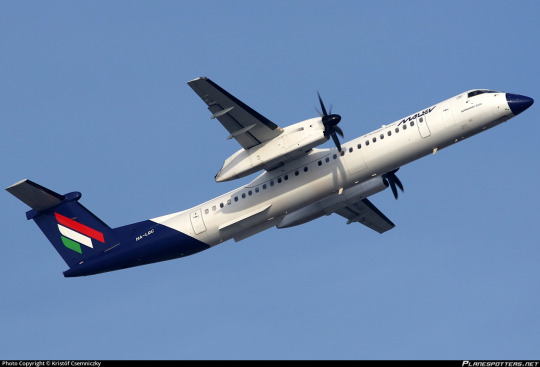
Nothing about MALÉV's livery really changes things drastically enough that it fundamentally deviates from the Lufthansa Line archetype, but it feels like the tiny tweaks change just enough that I actually think it's pretty okay. The painted nose, in particular, does a lot for me. I can't help but wonder if I'm being too kind to MALÉV because they operated so many pointy, angular, square airframes that really prevent the weaknesses of the Lufthansa Line from showing, and I try not to judge based on mitigating airframe factors if the airline operates types that aren't so lucky, but I just can't help but think the nose does add something very tangible, a sense of forward motion and a feeling of character that makes me hate it distinctly less, and the color choices are also nice!

And it's this feeling of character that keeps me...not really disliking this livery even though I will freely acknowledge it's lacking. There's something compelling accomplished just by painting the nose. I almost find that bizarre.

But, honestly...mostly white or not, I think these planes have enough color to them at the tarmac at Budapest wouldn't seem completely desolate. I think they'd go well with Wizz Air too. So, I mean...I think ultimately I like MALÉV, yes.
I'm going to give them a C+.
I can't justify going higher than that. But the main impression I've taken away is that I really wish MALÉV got a chance to overhaul their livery for the 2020s. What they had in their final phase actually looks quite contemporary, but that's because it was played out before it became an actual trend - introduced 1986, it predates even FedEx. I definitely can't rule out that whatever they redesigned this into would be worse, but as long as they kept the painted nose that's at least one thing I like a lot.

I've heard the Hungarian government would like to someday resurrect MALÉV if finances allow. To be clear, I do mean that I've heard it secondhand, but I can't find the actual source on it. This may be because I don't read Hungarian, but I think it would be nice to see. Even if there's a fifteen or even twenty-year gap, that's a better thing to see for a legacy which spans three-quarters of a century than for it to end there, and it's about time Hungary had a flag carrier again.
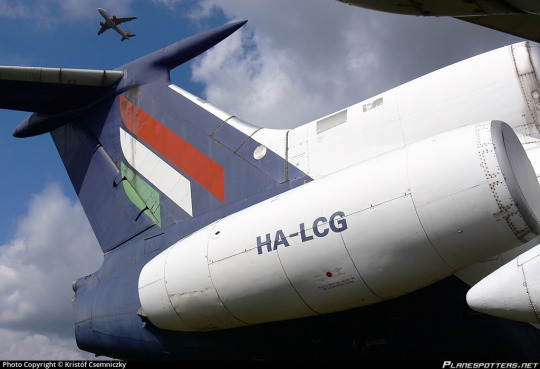
―――――――――――――――――――――――――――――――
Footnotes are so fantastic and useful. Why haven't I been using footnotes until now? I digress so much, why haven't I been making my posts more legible? I mean, tumblr unfortunately doesn't let you link to part of a post so they're not as useful as they are on other websites, but, like, no worse than endnotes in a book, right? And I deal with those all the time with very little grumbling.
[1] You can even still take a sightseeing flight on HA-LIX, or see her at airshows, where she looks fantastic for her 74 years of age (built 1949). She is operated by the Goldtimer Foundation on behalf of her owners, the Hadtörténeti Museum, still wearing the livery of her former operator, MALÉV. She even just got a round of restoration in early 2022, and is potentially the only airworthy Li-2 in the entire world of over 5,000 built, as it's thought the only other recent user, the North Korean Air Force, has mothballed theirs. [2]: I saw multiple mentions of László Zsótér as the designer of this livery, but cannot find any mention of whether he worked for an outside agency or was in-house at MALÉV. [3]: I mean, when you think about it, all of MALÉV's airplanes are painted birds. [4]: ie, schemes that are also primarily red and green but include other color(s) like blue, yellow, or black - see Ethiopian Airlines or MEA for an example - as well as honestly color schemes that are just red and white or green and white. It's honestly as bad as red, white, and blue.
#tarmac fashion week#grade: c+#region: central europe#region: hungary#malév hungarian airlines#flag carriers#defunct carriers#requests#era: 1960s#era: 1940s#era: 1950s#era: 1970s#era: 1980s#era: 1990s#era: 2000s#era: 2010s#region: soviet bloc#lufthansa line
13 notes
·
View notes
Text
A federal appeals court struck down net neutrality on Thursday, ending the widely popular regulatory doctrine that mandated internet service providers to treat all internet traffic equally.
The ruling from the 6th Circuit Court of Appeals ends a federal rule prohibiting broadband providers from throttling internet speeds or blocking traffic to specific sites.
“The FCC lacks the statutory authority to impose its desired net-neutrality policies,” the judges wrote, overturning what they called the Federal Communication Commission’s “heavy-handed regulatory regime.”
The pro-consumer policy of net neutrality was implemented by President Barack Obama and gutted during Donald Trump's first term. It was reinstated in April of last year by the Biden administration. The now-defunct policy holds that internet carriers are akin to telecom providers and must comply with common carrier regulations governing those services.
Telecom giants like Verizon and AT&T have opposed the policy for nearly a decade, spending big money to back anti-regulation candidates.
402 notes
·
View notes
Text
The Night Before the Tribute In Light
September 10, 2003

I.
One month ago today, this long-forgotten photo suddenly popped up in the photo app on my laptop. I took this photo with my Sanyo clamshell phone on September 10, 2003, 21 years ago tonight, from Hudson River Park in Manhattan.
Don't ask me how it survived all these years or where it's been stored all this time or how in the world it could have found its way to me from the long-dead storage servers of a long-defunct cell phone carrier. We're in the penumbra of The Anniversary, and time is out of joint.
I had been back in New York for about a month (after getting violently run out of the place I was staying by a fellow who is now one of my closest friends), homeless and living in that roach-infested HIV crack-house shelter at 96th and Broadway that I describe in "The One Decent Thing I Ever Did" (it’s archived on this blog), and you can imagine my state of head and spirit at this moment, the night before the 2nd anniversary of the terror attacks on the World Trade Center that drove me from my home in Lower Manhattan, four blocks east of the site.
I was sitting on a bench in Hudson River Park on the West Side of Manhattan, somewhere near Houston Street, maybe ten or fifteen blocks north of World Trade. I hadn't noticed these beams of light as I walked, and I think they might have just been activated while I was sitting there. As I recall, it was a full moon in Virgo, and I was positioned just right to snap this shot. I had *no* idea what this was all about, as I recall, but I thought the image was so striking and affecting that I wanted to capture it.
As it turns out, this was the tech run-through for the first September 11th installation of the “Tribute In Light”. Here’s Google’s AI summary of this remarkable memorial:

So there I was, just two years after the blast, stunned by this sudden, mysterious apparition rising from just south of what was still a giant, messy hole in the ground. I was still not fully myself at that time and would not regain my full memory or sense of who I was until the following January (therein lies a tale!), and as I recall I was just numbly stunned, not knowing what to make of it.
As I write, I’m getting the physical sense memory of that moment: the dog in me (my medulla oblongata speaking) feels his hackles rise, it’s not what I expect to see filling the hole in the sky, is it another attack? Do I bark at it, sound an alarm, run towards it, away from it, why is there light there, is this some unholy ruse, another trick being played on me from that big smoky hole where nothing but poison has spilled out for the longest time?
My phone rang. It was a fellow that I had met and hung out with in San Francisco while I was stranded there, and I was stunned to hear from him, especially at that moment. “Hi Dave… well, right now I’m on the riverfront looking at the damnedest thing… [I just wanted to make sure you were ok] hey, thanks for checking in… yeah, take care bud.” I closed the phone and started walking south along the riverfront, toward the light beams.
When I got there, I saw the massive banks of klieg lights assembled in their arrays, a strange and unfamiliar (unwelcome) echo of the shapes and the placement and the footprints of the place I loved so well.
The faces of the artists who surrounded the lights were intense, focused, sober. I still didn’t quite know what was going on, but there was profound reverence in the air, on those faces, at that place, as the beams of pure white light soared upwards, past the point of naked-eye discernment, unending, likely petering out tens of thousands of feet off that spoiled piece of ground, perhaps piercing the ionosphere, did they get clearance from the Federal Aviation Administration for this? Are pilots being disoriented by these columns at 45,000 feet? Do they touch the feet of God?
II.
And I kept walking south, my back to the light,
Down to the oldest part of the civilized island,
Past the Battery, the bronze bull, the buttonwood tree,
The Port of New York dead ahead,
The Staten Island Ferry terminal, ramshackle, ancient,
Entry restricted by terror tape and armed sentinels
No two uniforms alike, a panoply of enforcement,
Heavy weapons at the ready, so jarring in my neighborhood,
And the working dogs with the keen snouts, the trained muzzles,
Jumping up to paw at the brown bag in the soldier’s hand
Is that peanut butter? Apple? Hunk of cheese?
Let’s play! You’ve been so serious, so worried,
You smell sad and scared, are you lost? Let’s play!
Even Cerberus needs break time, belly rubs, treats!
For the first time in weeks, I smile to myself
As I round past the ferry, those strange lights at my back.
Hope I can sneak past the turnstile downstairs,
I won’t have to hike back up three hundred blocks
To that awful low place. Did you know roaches bite?
They shit on you too. Try to sleep, fully dressed,
Watch cap pulled low on my head, long sleeved shirt
Buttoned up to the collar, heavy pants tucked in boots,
Gloves on my hands, one more night without food
Half-bag of speed takes my mind off the pain
Sleep comes in fits if at all. – On the train
Dreading the stop: ninety-sixth street and Broadway.
Tomorrow, this city will jack itself off
In performative weeping and gnashing and cursing
Oh, how we loved them! I snort in derision,
You didn’t lose nothin', you pieces of shit!
Let the dead bury the dead. Beams of light
Don’t feed this refugee reeking of ashes -
What, do I smell bad? So sorry to stink up
The place where you’ve laid out the feast for your friends
Who still have their jobs, their high homes in the towers
Behind the glass doors where your larders are stocked
With the food that you bought with your government money
That flooded your midtown Manhattan apartment
With all the new clothes, electronics, the sausages
Fresh from Enrico’s, Zabar’s, D’agostino’s,
Bought with the Victim’s Fund money you stole
When you filed your claim. “OMG, it was awful!
“I couldn’t get up to the fifty-fourth floor,
“I had to find shelter on Upper Park Avenue.
“Power was out. I was homeless that night!
“So glad that my friend who was shopping in Gramercy
“Gave me the number to call for my claim
“September 11th was horrid! I told them
“I couldn’t go home for two nights! Oh, thank God
“The claim got approved with a wink and a nod
“And no one’s the wiser – I’ve never been south
“Of the Plaza Hotel! That all happened on Wall Street,
“Who goes down there? Jesus Christ, are you kidding?
“That’s four miles away! Christopher, are you coming
“Or what? Reservations at Nobu won’t wait
“For you or for me, so quit primping!”
The pain
In my stomach, relentless. My gorge won’t stop heaving.
Am I gonna make it? Damn, *ouch!* What the fuck…
The tooth that I hoped would hold out just gave way,
Fuck me. Another huge hole in my grille.
When I made six figures and lived in a high-rise,
Fuck buddies laughing on Saturday night,
Nobody told me that one hundred minutes
And two hijacked jet planes would make such a difference.
No one will laugh with me now – my best friends
Are yelling and angry, how dare I show up
Sweaty and toothless, a walking reminder
Of September tenth. No, I’m not gonna feed you.
III.
Now, twenty years later, they’ve retooled their memory:
“Animal! Damn, dog! We’ve missed you, you know,
“Wow, you’re alive! You look fabulous! Listen,
“I never gave up on you. Give a call
“When you come to the City. I want you to meet
“My beautiful husband – he remembers you too!”
IV.
Twin beams of light where the Towers were anchored,
Okay, not exactly precisely those spots,
But who’s gonna criticize? Look and recall
How majestic they were. Yeah, the new One World Trade
Is cool, I suppose – no one mentions the absence
Of Two World Trade Center. Insurance, you know.
Not enough money or civic ambition,
And Bloomberg discouraged it. Why add a target?
“Don’t you think sixty or seventy stories
“Are more than enough? Hell, let’s just get it done.
“The sooner we finish construction, the better.”
V.
*There will never be lumens of adequate volume
Sufficient to seal that hole in the sky,
But the hole in my heart I will finish, I tell you.
Walk with me as I go forward. Tomorrow
I’m back in the studio. Tonight, we can play!
You smell like apples and – damn, is that chocolate?
(our light beams shine upward forever)
"Good boy!"
Animal J. Smith
San Francisco, California
September 10, 2024
#i am alive#information gladly given#animal j. smith#September 11#9/11#9/11 survivor#recalled to life#tribute in light#2003#nothing and then suddenly something#a collaboration with once we were islands#berlin late 2025
63 notes
·
View notes
Text
The latest fallout from a Supreme Court ruling against regulatory power is a major win for internet providers
A federal appeals court struck down net neutrality on Thursday, ending the widely popular regulatory doctrine that mandated internet service providers to treat all internet traffic equally.The ruling from the 6th Circuit Court of Appeals ends a federal rule prohibiting broadband providers from throttling internet speeds or blocking traffic to specific sites.
The pro-consumer policy of net neutrality was implemented by President Barack Obama and gutted during Donald Trump's first term. It was reinstated in April of last year by the Biden administration. The now-defunct policy holds that internet carriers are akin to telecom providers and must comply with common carrier regulations governing those services.
Telecom giants like Verizon and AT&T have opposed the policy for nearly a decade, spending big money to back anti-regulation candidates.
The ruling, handed down on Thursday from three Republican judicial appointees, cited the Supreme Court’s recent overturning of the long-held precedent of "Chevron deference," which asked lower courts to defer to federal agencies' interpretation of the law.
Conservative federal courts have spent the last several years rolling back regulatory protections and the administrative state, with cases limiting the powers of the Environmental Protection Agency, pushing back against the Department of Education's authority to cancel student loans and blocking a Biden administration ban on trans healthcare discrimination.
More at the link.
11 notes
·
View notes
Text
Originally published in anthology Origin, 2022. Format adapted for Tumblr.
Footnotes referencing earlier auto-writing.
Title: Archival Entry #476
[The following is a digitised annotated script of what appears to be a guided sleep meditation podcast. However, no supporting records of the podcast have been found to date. The archival staff theorise that the original document is an unpublished manuscript rather than a transcript as the implied existence of eleven prior episodes remain unsubstantiated save for rumours of a defunct website. The anonymously submitted script was typed and printed, with handwritten annotations in the margins. When digitising this script, the lengthy annotations were converted into footnotes.]
Sleep is healing. Sleep is rejuvenating. Sleep is the inevitable journey your consciousness makes to the bordering verge of oblivion.¹ Sleep well and wake up anew tomorrow, dear listeners… or don’t. Good evening listeners, and welcome back to REMnant, your nightly guided meditation exercise, where we practise visualisation to relax your body for deep, uninterrupted sleep.
As we begin this exercise, you will trust only my voice and my guidance. Before we begin, please find a private, comfortable resting area away from sources of light and noise. You are recommended to use headphones to minimise external interference.
June 15th, 2001. Episode 12: Rebirth.
Let us start with a breathing exercise.
Breathe in. Feel the cool air travelling through you. Feel your lungs expand slowly, feel the dust within rise and settle. Feel the breeze clearing the cavernous space inside your chest, light from a gap timidly illuminating its smooth walls. You know each grain of sand and earth beneath your feet and hum with the wind that whistles through each crack in the walls. You feel drawn to the entrance and nearly take a step...
Breathe out, slowly. Feel the warm air rush from the cavern and out through your mouth. Return to your body, where you have two lungs and a gently beating heart within the walls of your chest.
Inhale. Feel senses out of your reach sharpen. You are opening your eyes to the world I create.
Exhale. Let your involuntary existence secede. You are oblivious to your reality.
Continue to breathe and listen.
Imagine for a moment an unformed, flickering light, holding within it the unlimited creative potential of life. Residing within the cavern inside your chest, inside your ribcage, inside your heart, it is housed in the universe inside of you but you cannot interact with it. As you breathe in it brightens and as you breathe out it dims, its life tethered to your own.
You nurture it unwittingly, for the universe outside of you is reflected within. Everything you learn, every choice you make shapes the world within you.
Is this fragile life a child to one day be born and leave you behind? Perhaps, but you are deeply mistaken if you believe birth is finite. With each breath you take the nascent consciousness surfaces briefly, the cries of its birth echoing through your changing thoughts... its carrier dies and you are born and so you die for the next to live.² Your future lives intolerably within you waiting ceaselessly to become your present, each infinite option you may take extinguishing countless of its iterations without care.
But why should you care? Creation necessitates the singular elimination of all other possibilities.³ An artist finishes their painting by discarding all previous drafts - though unsatisfied, though in mourning.
How would you explain the continuity of your selfhood? Even a video fills in with imagination the gaps between each frame, mere snapshots of linear passage arranged in close succession. Each frame birthing the next faster than our eyes can perceive. It is in these gaps that fear arises - what losses do memory suffer, what changes go unrecognised?
We are defined by our continuity and we assume a singular source... Don't stop breathing now, listener. Clasp your hands together and rest, deathly still.
The gaps in our consciousness are as infinite as consciousness itself, but today we are only to speak of the fissure that is sleep. In the following visualisation exercise, escape for a moment your frail, inactive body and give in to my voice... Listen and envision yourself in my place.⁴
When I was a child I was afraid to sleep. Drowning in worn mattresses stacked atop one another, I breathed in and out. In, steadily, and out, the way you are right now. Your lungs expanding…
Do you see the rhythmic whirring of the fan, gentle as softly stirring curtains? They were blue and sheer against the dimly orange lights. The distant sounds of traffic were muffled through the bubble of height. Your room was so far above the cars and the trucks and the speeding motorcycles. Sunken into the warm sheets and curled around a pillow, you were the only child in your world.
But when you were a child you were afraid to sleep. You stayed up every night, straining your eyes open in the dark and fighting for consciousness. Still, you never would catch the exact moment you slip, slackened into that sirenic grip.
Eventually, all succumbs to sleep.
You never dream. It seems as though you are pulled directly from your body and replaced every morning with a fearful spirit. You wake up feeling utterly disgruntled and estranged from your body. How can you know for sure you are the same person as you were the day before?
It is a naive thought that sleep is the only break in continuity that plagues your fleeting life, but it is the only one you cannot ignore. Our memories of the past are distant and uncertain even though we know we are formed by nothing but the past, just as we will form entirely the future.
You complete your morning routine while gazing uneasily at the mirror, memorising each freckle and flaw that you are sure was missing the day before. Even the materiality of your existence is subject to change.
You've heard it disproved: the myth that cells in a human body are entirely renewed every seven years. Some cells like the ones in your heart can never be replaced, while others die and regenerate every day. Could you take reassurance in the cells that stay constant? Do you hinge your identity on some parts of your body more than you do the rest?
You know the body that is yours is not the one that stays the same, just as the shape of your consciousness cannot be quantified in frames. But you doubt.⁵
Every day, we die when we sleep, with each blinking lost, absent thought drifting without pulse in the natural rhythm of death and rebirth. Each night we dream enclosed in the dark, inside the body of a god that is neither holy nor kind, destined to die every moment we surface.
What was the origin - our origin? Our birth, the moment of conception, the origin of existence? or the spark of life, then awareness? Do we begin when we first learn of beginnings, or when we first know of death? Is every change a new beginning? At age 8 so sure of who we are only to tear it all apart at 10, 9, 8, 13, rebuild at 16, restart at 18— What continuity is there for children lost to memory?⁶ Who are we now? And where did that begin?
You're not here today to learn that you can reshape yourself. You're not here to learn how to change. Like everyone else you know, you are helpless against your nature. Change will happen whether or not you try. You will awake different - despite and regardless of your efforts.
Listen and accept, for all you can do is believe me. Change is random, change is predetermined. Is a child, weakly breathing, a result of fate or accident? Is birth freedom or damnation? You are born moment by moment despite yourself, and always will you seek to understand the origin that moments ago was yourself.
In that world inside you, your future sleeps uneasily, restless and shifting and flickering beneath your gaze. If you relax and breathe out, can you imagine emerging from yourself?
A neverending origin story where each change is a new birth, and time and time again we die to emerge and surface only to disappear. As for the past that bears our present, we cling to traces of their passage, evidence of our extinct existence. But our birth cleaved us from one another, and the past lay dead for us to devour.⁷
Your shoulders are still tense, listener, your brows are furrowed and every muscle down to your feet. You will never return to the cavern inside you, and you will never find the light that you seek. The past ejects you while the future eludes your grasp, so all you can do is devour.
You lay awake and cry.
Why can't you sleep? Why can you never sleep, pathetic listener, awake still and listening to me? Though I offer no words of comfort and you have made no amends? Until the desperate outpouring stops, you hide beneath the blankets, foetal and miserable, waiting for tomorrow to birth another you.
End of Episode 12.
———
¹ [Underlined by annotator.]
² All of us like gods with worlds of our own, harbouring a consciousness that inherits the fate of creation and responsibility of conception, again and again, each world nurturing a god that will create a world, within which the same creator will have been born, worlds within worlds, gods within gods, I know I know but how metaphorical can this be when my heart drums in my head with the truth of these words? I need to sleep I need to be asleep
³ [Highlighted by annotator.]
⁴ There was a sound here, some kind of interference or a slight change in sound quality. I don’t know. Maybe I imagined it? Memory is deceiving and right now the only sound is how I read their words aloud to myself and the sound of pencil against paper as I annotate. Whoever receives this - you won’t mind marginalia, would you?
⁵ [Both highlighted and crossed out by annotator.]
⁶ God help us but surely there is continuity! Are we not inextricably connected to our origins? What succession of cause and effect tracing back without end, turtles all the way down… and when I search, never to reach the centre of the eternally expanding gap, unending birth with no severance. as the origin of my originator, unfolding in paradox in search of the beginning like a god within a world of my creation fighting inescapably to emerge from myself
⁷ Our past selves must have borne the agony of our current existence with resentment, feeding and gouging until they could be rid of us, could become us, cursing our inevitable birth, dreading and anticipating the ultimate divorcement where the past become obsolete, the meaningless nature of their consciousness, the separation of a child from the body of its creator that marks us all abject all untethered, what happened to my memories? Not a single face remains nor a single word can be heard. I know only memory of memory, corruptible memory unascertained
7 notes
·
View notes
Note
End of year asks:
8, 9, 12, 19
Game of the year: I don't play a ton of new games so I'm never great at these but this year it pretty clearly goes to 1000xRESIST which was recommended to me by my bestie Tanis and immediately I blitzed through it in a single day, amazing game that gave me a lot of NieR:Automata vibes while being a game that juggled an unreasonable amount of plates and absolutely nailed everything it was going for except for maybe the ending which I found a bit disappointing, amazing game though, in the future the crown may get stole by Metaphor:Refantazio which I just started playing yesterday and is apparently basically off-brand Persona 6 which is very high potential for me but, I've only played 1 hour at time of writing
Best month of the year: I had to look through my calendar and this is tricky but I'm going to go with July, the month me and my bestie Tanis drove out to Spokane together to be guests at a sadly now defunct con out there and met some amazing people, ate some amazing food, and generally had a great time
New friend I made this year: shoutouts to my new friend @the-dao-of-the-zerg whose username I just happened to see on a random tumblr post and was like 'oh shit I like both of those things' and followed on a whim and eventually reached out with the hope of becoming internet friends and then found out he lives 40 minutes away from me so we met up and found out we have even more in common and he runs these super fun queer boardgame meetups which I've now been to 4 of and we've been friends ever since
Looking forward to for next year: I'm really looking forward to moving out of my current place and getting to live alone for the first time in my life, I'm also looking forward to staffing my local con for the 3rd year in a row and getting to be an assistant coordinator for a 2nd year with a lot more experience this time to do things better, and I'm looking forward to becoming a full time carrier and having a regular routine and schedule
3 notes
·
View notes
Text
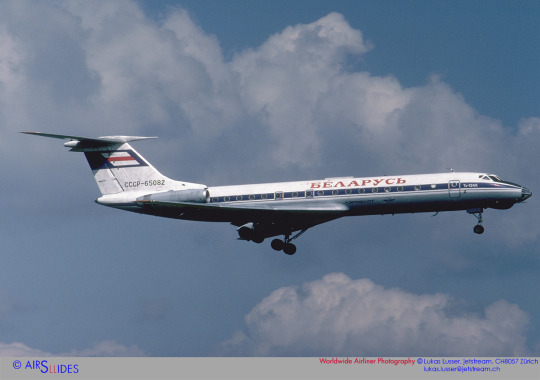
airsLLide No. 9497: CCCP-65082, Tupolev 134A-3, Aeroflot Belarussija, Zürich, August 29, 1993.
Actually quite a critter in several respects: Although flying for the flag carrier of Belarus - later to be known as Belavia - the Tupolev 134 not only still wears the basic colours of Aeroflot, but also a Sovjet tailnumber, despite the fact that these had officially been replaced with individual country prefixes for the newly created States in the territory of the defunct USSR. Furthermore, it does - much to the despise of the Russian flag carrier - still trade under the Aeroflot-name, mostly for reasons of international traffic rights.
All these pecularities are proof of the sometimes wild transformation going on in the former USSR at that time, and within the next year or so, all these "transitional issues" would be resolved, with Belavia being branded along with a distinct livery, and country prefix EW- being applied to aircraft of Belarus.
4 notes
·
View notes
Text
This day in history

On September 22, I'm (virtually) presenting at the DIG Festival in Modena, Italy. That night, I'll be in person at LA's Book Soup for the launch of Justin C Key's "The World Wasn’t Ready for You." On September 27, I'll be at Chevalier's Books in Los Angeles with Brian Merchant for a joint launch for my new book The Internet Con and his new book, Blood in the Machine.

#20yrsago Fed cop slams Verisign https://web.archive.org/web/20030923083005/http://dnm.sieve.net/tdw/2003_09_01_entry.html
#15yrsago Cybersquatters register domains for potential bank-mergers https://www.theguardian.com/business/2008/sep/21/technology.banking
#10yrsago Implementing a Turing machine in Excel https://www.felienne.com/archives/2974
#10yrsago Ryanair vows to reduce fewer customers to tears https://www.bbc.com/news/world-europe-24171384
#10yrsago Jungle Boat skipper gives a tour of the wall around the construction site https://www.youtube.com/watch?v=DakW1GtyTVA
#10yrsago Terms and Conditions May Apply: documentary about abusive license terms, privacy and surveillance https://www.theguardian.com/technology/2013/sep/19/data-digital-identity-cullen-hoback
#5yrsago Defunct Vancouver tech retailer’s servers sold off, containing credit cards and other customer details https://www.eteknix.com/ncix-database-servers-sold-craigslist-without-wiped/
#5yrsago California farm lobby’s sellout to John Deere will cost its members their right to repair https://www.wired.com/story/john-deere-farmers-right-to-repair/
#5yrsago Middle school cop who arrested seventh graders “to prove a point” may yet face consequences https://www.techdirt.com/2018/09/20/ninth-circuit-says-no-you-fucking-may-not-arrest-bunch-middle-school-students-to-prove-point/
#5yrsago Puerto Rico is a tax-haven for rich mainlanders and is also too broke to survive hurricanes: are these facts possibly related, somehow? https://www.gq.com/story/how-puerto-rico-became-tax-haven-for-super-rich
#5yrsago Carriers to FCC: Americans would totally be happy with throttled, capped wireless at home instead of home fiber https://arstechnica.com/tech-policy/2018/09/despite-data-caps-and-throttling-industry-says-mobile-can-replace-home-internet/
#5yrsago Nature’s greatest con-artists: the parasitic beetles that trick ants into barfing into their mouths https://www.youtube.com/watch?v=MJ-k0TBwvL0
#5yrsago Supreme Court decision will rip away Dark Money’s veil of secrecy https://www.commondreams.org/news/2018/09/19/supreme-court-decision-dark-money-were-about-know-lot-more-about-who-funding-our
#5yrsago As Canada-US trade-war draws nigh, so does the threat to nationalise US pharma patents https://ca.finance.yahoo.com/news/canadian-officials-mulling-attack-u-s-pharma-says-ottawa-lawyer-165038690.html
#5yrsago Europe’s copyright catastrophe is a harbinger of bad times for Canadians https://macleans.ca/opinion/the-spectre-of-bad-internet-laws-in-europe-should-be-a-warning-shot-for-canadians/
#1yrago Book-banning wingnuts are a tiny, vocal minority https://pluralistic.net/2022/09/20/the-moral-majority/#is-neither


7 notes
·
View notes
Text






Patriot Performance Materials Y Popup Pouch Prototype - Old School!
Patriot Performance Materials, a now defunct military gear manufacturer of the early to mid 2000s, was at a time a relatively popular brand in the early GWOT years, producing PPE like chest rigs, plate carriers, and pouches. Nowadays their designs are of course seriously outdated in methodology with that iconic overbuilt bulkiness of early GWOT gear, featuring heavy use of 1000D cordura. At the time of writing, this brand of gear still floats around in the militaria market, and I was able to obtain this pouch from a vendor selling items that were obtained at the Patriot Performance factory in North Carolina as it was closing down. Several of these items were prototype pouches, labeled as "Y" pouches. This is one example of a pop flare pouch prototype - being used to hold a Broco Jimmy Prybar on my plate carrier back panel.
Full Album Here.
2 notes
·
View notes
Text

The man who stole America’s stealth fighter secrets for China 🇨🇳
It’s not uncommon to hear people say that China’s most advanced stealth fighters, the in-service Chengdu J-20 and forthcoming Shenyang FC-31, incorporate stolen design elements from existing American and Russian fighter programs. Russian allegations of copycat technology are born largely out of overall similarities between the J-20 and Russia’s long-defunct MiG 1.44 program. However, although Russian allegations leave at least some room for debate the same can’t be said for China’s theft of American stealth fighter designs.
In March 2016, a 51-year-old Chinese national named Su Bin pled guilty to charges associated with what the American Justice Department described as a “years-long conspiracy” conducted in concert with high-ranking members of the Chinese military to steal American military secrets – most notably, the designs for advanced stealth fighters like the F-22 and F-35.
“Su admitted that he conspired with two persons in China from October 2008 to March 2014 to gain unauthorized access to protected computer networks in the United States – including computers belonging to the Boeing Company in Orange County, California – to obtain sensitive military information and to export that information illegally from the United States to China,” reads the Justice Department release.
Su Bin, who worked in Canada under the name Stephen Su, was a well-regarded businessman and entrepreneur in the aviation industry, serving as the sole proprietor of a small company that specialized in aircraft cable harnesses. This company, called Lode-Tech, was described by the Air Force Office of Special Investigations as a “small player” in the field, with only a handful of employees and limited access to broader aviation programs.
However, despite the minimal reach of Lode-Tech, Su Bin himself worked tirelessly to establish in-roads within the Canadian and American defense industries, forming an extensive network of business contacts that, over time, allowed him to gain increasingly unfettered access to internal networks maintained by a variety of American and Canadian defense contractors.
As Bob Anderson, the FBI’s former head of counterintelligence, put it, “he cultivates you over time.”
China began formal development on its first stealth fighter, meant to compete directly with Western jets like the F-22, in 2008, awarding the Chengdu Aerospace Corporation a developmental contract meant to mature its Project 718 design proposal.
Starting that same year, Su began working directly with two professional hackers employed by China’s People’s Liberation Army, using the information he’d gained through his business contacts to enable the theft of more than 630,000 files from Boeing – a massive 65 gigabytes of data – related to the C-17 heavy-lift cargo aircraft. But Su had his sights set on an even bigger prize: information regarding America’s stealth fighter programs.
Related: Beating China could mean bringing the C-130 back to aircraft carriers

A five-ship formation consisting of a C-17 Globemaster III and four F-22 Raptors fly over Joint Base Pearl Harbor-Hickam, Hawaii. (U.S. Air Force photo by Tech. Sgt. Heather Redman)
Over time, Su’s ability to win over business contacts enabled the theft of even more information mostly on the development of Lockheed Martin’s F-22 Raptor and F-35 Lightning II. While Su did not immediately have access to Lockheed Martin’s networks, these aircraft were not designed or built solely within the halls of Lockheed Martin. Both of these fighters represent the efforts of a chorus of contractors and subcontractors, with design specifications shared across firms for the sake of manufacturing.
When people took note of Su’s interest in these classified programs, he assuaged their concerns by pointing out that he was only asking about specific, seemingly unimportant things.
“Su would say, ‘I’m not asking you to give me the F-35, but what’s it matter if I get one system out of it that we could sell to a friend or a prospective client?’” said Anderson. “And then go from there, and it takes time.”
Over at least six years, Su and his hackers would gain access to tens of thousands of files associated with these stealth fighter programs.
Correspondence between Su and his team shows he not only provided overall direction and guidance for this effort, but he even worked to translate the stolen information into Chinese, going so far as to draft formal reports for the PLA’s General Staff Headquarters on the material they managed to steal.
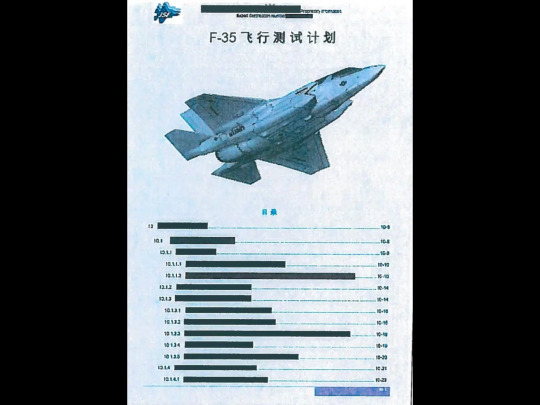
A redacted image from the F-35 report Su Bin prepared for the PLA’s General Staff Headquarters. (Creative Commons)
Su and his co-conspirators may have worked tirelessly to gain access to this information, but they worked just as hard to cover their tracks. FBI counter-intelligence experts traced their work through multiple third-party nations, where they had established “hop points” – a term used to describe compromised or purchased intermediary networks meant to disguise the infiltration’s actual point of origin.
In 2009, six current and former government officials confirmed with the Wall Street Journal that the Joint Strike Fighter Program that produced the F-35 had been accessed multiple times by Chinese hackers, who had secured several terabytes of information regarding the aircraft’s design and systems. At the time, Pentagon officials explained that the hackers used a method that encrypted data as it was being stolen, making it difficult to assess what specific data had been compromised. However, it is worth noting that some of the most secretive systems being developed for the aircraft are kept isolated from broader network access to avoid these sorts of security breaches. Nonetheless, this revelation was the beginning of the end for Su and his team.
In one 2011 e-mail entered into evidence, Su bragged to his Chinese contacts that the information they stole from the F-22 and F-35 programs would “allow us to rapidly catch up with U.S. levels … To stand easily on the giant’s shoulders.”
Beginning in 2011, in what Chinese officials might describe as little more than coincidental timing, the J-20 fighter design that had been maturing since 2008 suddenly adopted several significant – and stealthy – changes. These changes wouldn’t manifest in a new prototype, however, for three more years.
By 2013, Su had also established connections with GE Aviation in Cincinnati – a firm renowned for advanced turbofan technologies that China has struggled to develop for its own stealth fighters. It’s worth noting that both the F-22 and F-35 are powered by Pratt & Whitney powerplants, but GE was responsible for competing designs meant for service aboard these jets. According to Defense Department insiders, GE’s YF120 turbofan proposal for the F-22 Raptor was actually the more advanced and capable design. Pratt’s YF119 engine ultimately won out due to its simplicity and the lower risk associated with relying on more mature and proven technologies.
In March 2014, China’s new and improved J-20 design finally emerged, incorporating modified diverterless supersonic inlets (DSI), redesigned vertical stabilizers, and more. When pictures of the new J-20 first reached the internet, multiple defense outlets highlighted the now even more pronounced similarities to Lockheed Martin’s stealth fighters.

Visible changes in China’s J-20 stealth fighter prototype fielded in 2014 (bottom) versus its previous iteration (top). (Via the Chinese internet)
As well-known aviation journalist David Cenciotti reported at the time, the J-20’s newly redesigned nose, in particular, bore a striking resemblance to the F-22 and F-35. That same year, USNI News contributor Feng Cao also drew direct comparisons to America’s stealth fighters, even highlighting its change in color to “F-22 grey,” likely a sign of improved radar-absorbent skin. Defense outlet War is Boring was so taken by the improved features of the new J-20 design that they ran a story with the headline, “China’s Latest Stealth Fighter Prototype Has, Well, Actual Stealth Features.”
Now, it is important to note that not all of the design changes to the J-20 are easily attributed to espionage. Some changes and improvements can be traced to on-record developmental efforts within Chinese academia… but not all of them. Nonetheless, the new-and-improved J-20 could be seen as a massive victory for Su Bin and his espionage efforts… but he wouldn’t have much time to celebrate. At right around the same time the new J-20 prototype was revealed to the world, the U.S. Department of Justice filed a criminal complaint and subsequent indictment against Su for the theft of thousands of files associated with American defense efforts. Four months later, in July 2014, he was arrested by Canadian authorities.
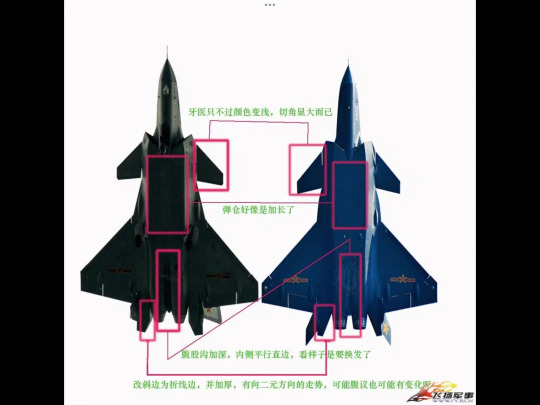
Visible changes in China’s J-20 stealth fighter prototype fielded in 2014 (bottom) versus its previous iteration (top). (Via the Chinese internet)
While the FBI is traditionally responsible for investigating these sorts of crimes, the Air Force’s Office of Special Projects (PJ), a subset of the Office of Special Investigations, ultimately played a vital role in securing Bin’s arrest and extradition to the United States thanks to their ability to work directly with defense contractors and senior U.S. government officials, including members of the Air Force’s C-17 program office and others within Lockheed Martin itself.
American law enforcement eventually managed to access the messages exchanged between Su, his hackers, and Chinese military officials in which they wrote and revised formal reports for the People’s Liberation Army outlining their efforts and the data they’d managed to steal. The collection of stolen files combined with this correspondence left the charges all but irrefutable, and Su opted to wave the extradition hearing and be transferred directly to the United States.
Initially, Su was facing 30 years in prison for his crimes, but he quickly accepted a plea agreement, providing his full cooperation to American authorities in exchange for a much shorter 46-month sentence.
Despite the breadth of Su’s theft, many of the documents he and his hackers stole were not, strictly speaking, classified or even export-controlled. However, as the Air Force pointed out in 2016, even these less-significant thefts, in aggregate, allowed the Chinese military to reverse-engineer a wide variety of aircraft components that would otherwise have cost millions to develop from scratch, saving not only money, but a great deal of time associated with research and development.
Related: Pakistan wants to fly Chinese stealth fighters alongside its F-16s
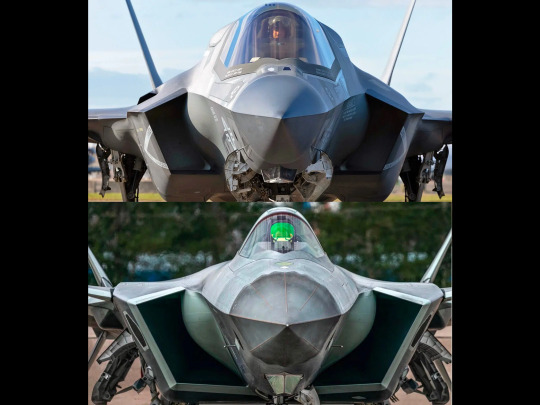
F-35 (top) compared to J-20 (bottom).
“Su Bin admitted to playing an important role in a conspiracy, originating in China, to illegally access sensitive military data, including data relating to military aircraft that are indispensable in keeping our military personnel safe,” said Assistant Attorney General Carlin.
Su’s unearthed correspondence, the timeline of design changes incorporated into the Chengdu J-20 stealth fighter, and his subsequent admission of guilt, all point directly to China’s theft, and use, of Lockheed Martin design elements in its own fighter programs, though this idea remains the subject of debate within Pentagon and aviation circles to this day.
The J-20 is obviously not a direct copy of the F-22, and assertions that it would need to be to benefit from this sort of technological theft reflect a lack of understanding of fighter design. A tactical aircraft is, fundamentally speaking, not one thing, so much as a broad collection of components and design cues married to one another through functional form. Like a child bearing only a slight visual resemblance to her parents, genetic similarities run more than skin deep.

Comparison of F-22 (top) and J-20 (bottom).
Yet, the most conspicuous similarities between Chinese and American stealth fighters are, nonetheless, fairly easy to spot. Despite the J-20’s overall delta-wing and canard design resembling Russia’s defunct MiG 1.44 stealth fighter effort, the radar-reflecting design cues leveraged by the F-22 and F-35 are readily visible in the Chinese fighter.
Some have disputed this in recent years by alleging that these similarities are based not on theft, but physics, claiming that these shared design elements are the inevitable result of any fighter design meant to marry aerobatic performance to low-observability. This claim would seem to be substantiated by numerous other stealth fighter programs in development today that also bear a striking resemblance to America’s F-22 or F-35, like Turkey’s KAAN, South Korea’s KF-21, or India’s AMCA.

The truth, however, is that both the Indian and South Korean stealth fighter efforts saw direct engineering support from Lockheed Martin, and Turkey’s KAAN fighter began development in 2016, three years before the country was removed from the F-35 program. These fighters bear a resemblance to Lockheed Martin’s because they all have benefitted from access to Lockheed Martin’s design efforts.
The idea that all stealth fighter designs will ultimately mature in the shape of an F-22 can be easily dismissed by simply looking over the competing stealth fighter developmental efforts from other firms that ultimately didn’t see production for one reason or another. Boeing’s admittedly goofy-looking X-32 and Northrop’s legendary YF-23, both jets that competed and lost against Lockheed entries, were not only broadly comparable in terms of stealth, but it’s widely understood that the YF-23 was even stealthier than the YF-22 that matured into today’s Raptor.
Other stealth aircraft efforts like Northrop’s Tacit Blue, Boeing’s YF-118G Bird of Prey, NASA’s X-36, McDonnell Douglas’s A-12 Avenger II, and more all represent different approaches to low-observable tactical aircraft design that bear little resemblance to Lockheed Martin’s approach.
Related: Why stealth helicopters are so hard to design

Northrop’s YF-23 stealth fighter design. (U.S. Air Force photo)
Put simply, Lockheed Martin didn’t uncover the one-and-only approach to stealth fighter design in the early 1990s, leaving the rest of the world with no choice but to follow in its footsteps. Instead, Lockheed Martin offered the U.S. military the most viable combination of performance, stealth, and political support necessary to see its jets go into production. Since then, Lockheed Martin’s success with these designs has positioned it to support American allies and partners in their own developmental efforts, resulting in a great deal of similarity across some foreign designs.
China’s use of Lockheed Martin design elements in its stealth fighters, then, does not represent the inevitable result of radar and wind-tunnel testing, but rather a concerted effort to bridge the gap between Chinese and American fighter technology through a combination of direct theft and a fair bit of traditional domestic R&D.
So what does this ultimately mean for China’s J-20 or their new stealth fighter in development, the FC-31 (sometimes also known as the J-35)? Espionage has always played a role in the advancement of military technology and will continue doing so as long as wars are waged. These fighters do not need to match their American counterparts in all performance metrics to represent a potent threat to American security and interests, and indeed, they likely don’t. Their real value is as part of a broader defensive strategy and air warfare doctrine that China is still actively developing as we speak, and as such, the ultimate impact of these platforms has yet to fully manifest.

China’s operational J-20 (Wikimedia Commons)
It would be a mistake to dismiss these copycat fighters as little more than designer-imposter jets with no real combat prowess due solely to their use of stolen design elements. A Hi-Point pistol may look like a Glock run through a broken copy machine and may not offer the same accuracy, reliability, or ease of maintenance… but that’s little solace to anyone who’s been shot by one. And the truth is, a highly trained special operator armed with nothing more than a cheap pistol may be even more dangerous to an opponent than a dummy like me with the fanciest Sig money can buy.
Effective employment strategies and tactics can often offset technological shortcomings, and as such, China’s employment of stealth technologies in new fighter designs doesn’t need to be as refined as America’s. With the right strategy, training, supporting systems, and personnel, the underdog can always come out on top.
So, did China steal F-22 and F-35 designs to benefit its ongoing fighter efforts? The answer is unequivocally yes.
But is that a reason to dismiss the threat posed by these aircraft and others to follow?
The answer there is unequivocally no.
@Alexhollings
@SandboxxNews
4 notes
·
View notes
Text
No. 25 - BWIA

@international-nerd asked me to discuss BWIA! I was very excited about this request when I first read it, and now I'm very excited while I write this. BWIA's 2000s livery, which is what I'll be focusing on here, is one that definitely stood out on the tarmac.

It's rare that I can emphatically say this about an airline livery, but it's sort of in a category of its own. If more carriers approached livery design like BWIA, I probably wouldn't have been frustrated enough with the state of things to make this blog in the first place, because their livery is the polar opposite of the timid, corporate, and generic design we expect from airlines.

I like this picture a lot because it looks like she's saying hello to you. Like a cat approaching to sniff your hand.
First taking to the air in 1940 under the name British West Indian Airways, BWIA was also known at various points as BWIA West Indies Airways, BWIA International Airways, or 'Bee-Wee'. Its website was bwee.com. I have begun saying 'bweeeeee......' to myself under my breath now whenever I'm alone.
BWIA was founded as a private company, then became a BOAC subsidiary, and then was rapidly acquired by the government of Trinidad and Tobago. From 1961 until its ultimate demise in 2006, BWIA was the flag carrier of Trinidad and Tobago and became the largest carrier in the Caribbean, serving destinations in North America, South America, the Caribbean, and Europe.

Back in the day they had this...boring standard thing, but by the 80s they expanded their horizons to the other half of the color wheel, picking up a recognizable teal-and-bright-yellow color scheme. Its various jets continued to wear this livery until around 2000.


Sure, one image could have sufficed, but I'm far too weak to resist the allure of putting a really cobby-looking plane next to a comically long-looking plane.
The yellow and teal was a step in the right direction, but in 2000 BWIA decided it was time to unleash their true power on airports across the world. And the result is the subject of this post.

Now there's a livery worth talking about.
Seeing images of this livery makes me feel temporally strange. This is an airline which I technically overlapped with, in the sense that I was alive while BWIA existed, but I'm just inherently too young to remember that. There's definitely a chance I saw one of these striking planes in person and just don't remember it because I was five or so years old, and that's a very strange thought. I wish I had managed to see one, and had held onto the memory somehow, because I love these planes.
Do I miss the hot pink lettering from the previous livery? Yes, a little bit. I won't deny that. But if I hadn't known it was there I wouldn't have had that thought, so I don't think that's anything to hold against them.

I think BWIA is a really good place to pick up after this week's first post, Icelandair, where I discussed flag carriers' branding and the fact that it should reflect the country it represents. Trinidad and Tobago's contributions to music are gigantic. It's the birthplace of calypso, though calypso is far from the only genre and far from the only tradition which originated there.
BWIA's logo is a stylized steelpan, a musical instrument invented in Trinidad and Tobago which I could talk about on its own for quite some time if I weren't insisting to myself that this post has to be about airplanes and not music, but it's a choice of logo that makes it immediately clear that this is an airline which represents a group of people rather than just a flag. If the culmination of a flag carrier's mission is to make a case for why it's flying to a place you should visit, this is an incredibly effective way to do that. Trinidad and Tobago is a place where music is born. It's not just islands with beaches, it's islands with people and if you go there you will have experiences you could never have anywhere else.
In terms of flag carrier logos, it's up there among my favorites. The older 2D version is a little harder to immediately identify as a steelpan but the 2000-onward 3D version is very clean and very uniquely BWIA's. It adds more detail but it never becomes cluttered. The steelpan shape and the teal-and-yellow colors are both distinctive on their own, and combined they make planes that are impossible to mistake for any other airline.

The steelpan logo is prominent both on the tail and wrapped around the bottom of the fuselage, starting about midway down the ventral fairing and ending just below the nose. I really admire BWIA's choice to go with white-on-blue rather than the blue-on-white any other airline would have chosen. It instantly elevates the livery from doing something interesting with the placement of its shapes to doing that and also stubbornly refusing to even approach Eurowhite.

The use of white where it is used is very nicely executed, though. It allows the overall design to maintain a lightness by avoiding black outlines, while preventing the sort of overt eyestrain that comes from putting yellow directly on this sort of light teal. Instead, it elegantly uses the yellow as an accent on the back half of the fuselage. It's difficult for me to even articulate why this works so well, but it just does. The colors look harmonious together despite never mixing, and it's not the sort of place a secondary color would normally be isolated, which I think might be why it's so brilliant. It's a really nice accent to the rest of the plane, preventing the flatness which could result from a livery made entirely of a light color and plain white, while not impinging on the steelpan logo. It draws the eye and then takes a step back to let it experience the rest of the plane, and when you take a step back and appreciate the livery as a single unit it prevents any of that detail from being lost in a blue-and-white blur.
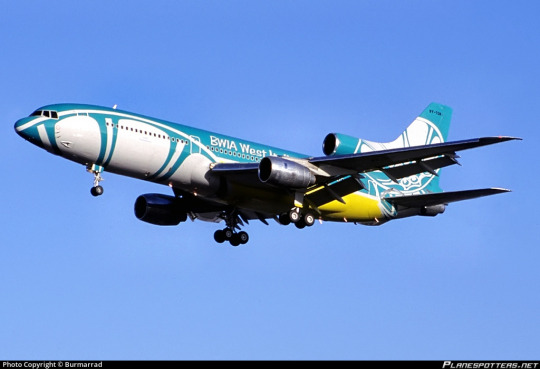

As with many liveries, I think BWIA's looks its best on a TriStar. That might be because the larger empennage lets you see more of the steelpan logo, but there's something so nice about the way the yellow peeks out from under the wing that reminds me of birds with bright yellow underbellies.
I think the main thing that sticks with me after looking at BWIA planes from every angle I can find images for is that this livery exemplifies a style of design that is the exact opposite of what makes most liveries so disappointing. This feels like a livery designed by someone who had never seen another airline livery before, who was sat down with some pencils, a color scheme, a logo, and an identity, and told to find a way to reflect it in the shape of the airplane. In so many of my other posts I compare liveries to each other, with the worst cases merging into uninspiring slop of aughts Delta clones and late 2010s Lufthansa clones and so forth. BWIA just didn't participate in any of that. This livery is hard to put words to because it's nearly impossible to compare to any other livery - in a good way. Most airlines' special occasion liveries don't have a fraction of this excitement.

This might sound a little lofty, and I don't mean to say that BWIA is what airlines should strive to directly emulate (in fact, by doing so they would sort of be doing the opposite of what BWIA did when they released this into a world full of Air France and United), but BWIA here has done what general relativity did to physics. Not so much a different equation, but a different state of mind. Taking what has always been treated as numbers and saying that it makes a lot more sense to think of it as fabric. And what I ultimately think is the most important outcome of these choices is that I can imagine any number of people watching other planes on the tarmac, bored out of their minds, snap out of their stupor to get a closer look when they see a BWIA plane roll by.

We unfortunately lost BWIA in 2006. It was for regular boring financial reasons, a similar situation to the more recent death of Alitalia where the government simply can't keep pumping money into something which has never turned a profit and has to start over with a new airline. I'm not going to talk about its successor, Caribbean Airlines, except to say that obviously I think it's a gigantic downgrade. Frankly, I could really like Caribbean Airlines and it wouldn't matter. If an impeccably designed livery is equivalent to someone who can answer any question you have about the body of physics scholarship, BWIA is equivalent to the sort of theorist who gets fundamental laws named for them.

A+, and goodnight.
#tarmac fashion week#grade: a+#era: 2000s#region: caribbean#region: trinidad and tobago#bwia#flag carriers#defunct airlines
48 notes
·
View notes
Text
Yoruichi Headcanon: In CFYOW, Shunsui asserts Yoruichi and Mayuri have equal intelligence gathering capabilities: “Well, Captain Kurotsuchi and Yoruichi have probably found out by their own methods. They probably even found out what happened next before I did.”
While the two of them had a truce thereafter, lasting through the demise of their competitor Tokinada, whom Yoruichi arranged for to be killed, that truce was already undermined by Mayuri's own actions at the meeting prior to the final battle with Tokinada: “Since the Quincy and the Arrancar Corpse Unit carry surveillance bacteria within them, I made the bacteria so that it automatically spreads to those that they fight. Naturally, all of you here are carriers already."
As it would be wholly unacceptable to Yoruichi to be tracked by Mayuri after having just disposed of her erstwhile rival at the Visual Department, and not entirely trusting Shunsui's demands that the bacteria be wiped, reprisal was inevitable. Accordingly, in early 2004, Yoruichi destroyed SRDI's data stores (and the backups, and the backups of the backups, and the backups of the backups of the backups...) relating to the surveillance bacteria and destroyed a significant fraction of its equipment related to it as well. She made sure the surveillance program was wholly defunct as a message.
This is on top of having stolen the Visual Department's records after ensuring Tokinada was dead, and likewise destroying much of their equipment too. In other words, the Seireitei's only "secret police" functionally remaining is the Onmitsukidō.
4 notes
·
View notes
Text
I know they're going to say it's a "deterrent" or but the way they've been just openly announcing troop movements it's starting to feel like they really are just banging the dinner bell for Iranian suicide boats as a pretext for war or a USS Liberty 2 where they blame it on Syria.
Thinking about that time the US military did a naval training exercise about a prospective invasion of Iran and the OPFOR general won by sending remote detonated RHIB drones to simulate detonating the American flagship carrier first so their entire formation fell apart. Then the Pentagon had an meltdown about it so they made them run the exercise again but explicitly forbid the OPFOR commander from using any of the tactics that he used to counter them. They even had basically the exact same combat force they're amassing today of two American carriers supported by marine assault ships and their escorts. Could you even begin to imagine the meltdown that would happen if we lost the Gerald Ford to a glorified jet ski?
3 notes
·
View notes
Text
The High-Flying Illusion: How the Airline Industry’s Golden Model Crashed and Burned
For years, the major airlines—American Airlines, Delta, and the now-defunct Continental—convinced themselves that they'd cracked the code to eternal profits. Their secret weapon? The oh-so-brilliant hub-and-spoke model. It worked like this: funnel all flights through a handful of major airports, keep the planes packed, and watch the money roll in. And for a while, it did.
But here's the thing about "brilliant" business models—they're only as good as the last quarter's profits. Enter Southwest and JetBlue, two low-cost carriers that waltzed in and shattered the illusion. While the big guys were busy herding passengers through overcrowded hubs like cattle, Southwest and JetBlue were flying between smaller, less congested airports at a fraction of the cost. No endless layovers, no exorbitant ticket prices. Simple, cheap, and efficient.
Their business model was so efficient, in fact, that it made the "strength" of the hub-and-spoke model look more like a noose. Operational inefficiencies, like running massive operations through a few overburdened airports, became glaring weaknesses. And to top it off, these newcomers slashed labor costs, forcing down ticket prices and sucking customers away faster than you can say "frequent flyer miles."
But wait—it gets worse. The airline industry's struggles were already brewing, but September 11, 2001, dropped a bomb on their precious business model. According to the Bureau of Transportation Statistics, air traffic plummeted post-9/11, and suddenly the airlines were left scrambling to fill their planes with far fewer passengers. So what did they do? The only thing they knew: offer more discounts, even deeper ones.
In a desperate attempt to cling to their fading business model, they slashed ticket prices to the bone, essentially giving seats away for free. And that, dear reader, is how the mighty hub-and-spoke model—a profit engine for decades—ended up on life support. What once seemed like a triumph of airline economics turned into an Achilles' heel, forcing the big carriers to keep their bloated, inefficient networks afloat as they hemorrhaged money.
It’s almost poetic, in a tragic kind of way. The very thing that had made them powerful ultimately became their downfall. Because in business, much like in life, what works today could leave you bankrupt tomorrow.
#AirlineIndustry#BusinessModels#HubAndSpoke#SouthwestEffect#CorporateDownfall#AviationEconomics#FailedStrategy#DisruptiveInnovation#AirlineCompetition#LessonsInBusiness
0 notes
Text
BBC 0430 21 Apr 2024
12095Khz 0359 21 APR 2024 - BBC (UNITED KINGDOM) in ENGLISH from TALATA VOLONONDRY. SINPO = 55445. English, dead carrier s/on @0358z with ID@0359z pips and Newsroom preview. @0401z World News anchored by Chris Berrow. The US House of Representatives has passed a major package of military aid for Ukraine after a six-month hold-up in a move Volodymyr Zelensky praised for keeping “history on the right track”. Democrats waved Ukrainian flags on the floor of the House as the bill authorising $60 billion (£48.5 billion) in lethal aid to be sent from US stockpiles passed by 311 votes to 112. Joe Biden’s plan to send aid to Ukraine, Israel and Taiwan had been held up in Congress for six months, amid opposition from Republicans who argued the war with Russia had become too expensive. One person was dead and seven missing after two Japanese military helicopters crashed after possibly colliding while out to sea, officials said. Sierra Leone authorities on Saturday burned $200,000 worth of narcotic drugs and chemicals used to manufacture the synthetic drug kush, two weeks after drug abuse was declared a national emergency. A candlelight vigil is being held for the victims of a stabbing at Bondi Junction Westfield in Sydney. Thousands of people are expected to attend the event to pay their respects to those who were injured in the attack. The vigil is a way for the community to come together in solidarity and support for the victims and their families during this difficult time. The turnout for the vigil is expected to be large, showing the strength and unity of the community in the face of tragedy. Israel will summon ambassadors of countries that voted for full Palestinian UN membership “for a protest talk” on Sunday, a foreign ministry spokesman said. It came after the Palestinian Authority said it would “reconsider” its relationship with the United States after Washington vetoed the Palestinian membership bid earlier this week. Thursday’s vote saw 12 countries on the UN Security Council back a resolution recommending full Palestinian membership and two, Britain and Switzerland, abstain. Two mayoral candidates were killed in two different parts of Mexico as the country heads to elections in June, authorities said. Center-right mayoral candidate Noe Ramos of Ciudad Mante was fatally stabbed in the northeastern state of Tamaulipas, said state attorney general Irving Barrios. Authorities are searching for the suspect. Meanwhile, in the southern state of Oaxaca, another mayoral candidate Alberto Antonio Garcia, was also found dead on Friday, according to the state prosecutor. More than 46,500 voters have been called to cast ballots on Sunday in four Serb-majority municipalities in the north of Kosovo. In an unprecedented process, they will not vote to elect mayors but to dismiss them. This is the first time Kosovo has organised this type of ballot in which voters can exercise their right to dismiss the mayors of Leposavic, North Mitrovica, Zvecan and Zubin Potok that they never considered as legitimate. But on Wednesday, the Central Election Commission, CEC, announced that 33 school premises in the four municipalities will not serve as polling stations because their directors refuse to allow the votes to be held there. The Basque Country will head to the polls this Sunday for a crucial regional election that could prove to be a political headache for incumbent Spanish Prime Minister Pedro Sanchez. Opinion polls ahead of this weekend’s ballot show the left-wing separatist EH Bildu party, partly descended from the political wing of the now-defunct terrorist group ETA, with a narrow lead over the ruling centrist Basque Nationalist Party (PNV). @0406z "The Newsroom" begins. 250ft unterminated BoG antenna pointed E/W w/MFJ-1020C active antenna (used as a preamplifier/preselector), Etón e1XM. 250kW, beamAz 315°, bearing 63° . Received at Plymouth, MN, United States, 15359KM from transmitter at Talata Volonondry. Local time: 2259.
0 notes
Text
Personal opinion
The West should be manufacturing more HIMARS, NLAWs, and TOW missiles for Ukraine for Christmas.
Reason being, Russian doctrine is mentally defunct and obsessed with the supremacy afforded against average dumb infantrymen via tank armor and slopes vs. small arms and small explosives. It invests incredibly in these machines and the infrastructure to support them. If you can therefore peel them apart like an ice type tears apart a dragonite (X4 effective against dragon/flying types), then you make the enemy expend millions while you spend maybe 6K-200K, depending on what you destroy their millions of dollars in tanks with.
They have a grand total of 3,500 or so left in stock, of all kinds, and can only produce about 20, maybe 40 a month at beyond full scale production. The Russian economy is cannibalizing itself like a vegan's body trying to sustain itself on veganism. It cannot sustain this war, and like any dumb, proud meathead, is willing to destroy itself in order to live up to its own romantic idealism of itself and save face in front of everyone.
When the Main Battle Tanks and Armored Personnel Carriers cease, then it's just down to blowing up Russia's radar trucks and MLRSes, and then their airforce. And then it's back to the drawing board.
0 notes